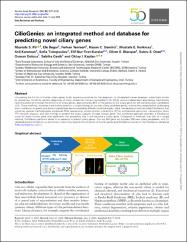| dc.contributor.author | Pir, Mustafa Samet | |
| dc.contributor.author | Begar, Efe | |
| dc.contributor.author | Yenisert, Ferhan | |
| dc.contributor.author | Demirci, Hasan C. | |
| dc.contributor.author | Korkmaz, Mustafa E. | |
| dc.contributor.author | Karaman, Asli | |
| dc.contributor.author | Tsiropoulou, Sofia | |
| dc.contributor.author | Firat-Karalar, Elif Nur | |
| dc.contributor.author | Blacque, Oliver E. | |
| dc.contributor.author | Oner, Sukru S. | |
| dc.contributor.author | Doluca, Osman | |
| dc.contributor.author | Cevik, Sebiha | |
| dc.contributor.author | Kaplan, Oktay Ismail | |
| dc.date.accessioned | 2024-08-20T08:46:47Z | |
| dc.date.available | 2024-08-20T08:46:47Z | |
| dc.date.issued | 2024 | en_US |
| dc.identifier.issn | 03051048 | |
| dc.identifier.uri | https://doi.org/10.1093/nar/gkae554 | |
| dc.identifier.uri | https://hdl.handle.net/20.500.12573/2336 | |
| dc.description.abstract | Uncovering the full list of human ciliary genes holds enormous promise for the diagnosis of cilia-related human diseases, collectively known as ciliopathies. Currently, genetic diagnoses of many ciliopathies remain incomplete (1–3). While various independent approaches theoretically have the potential to reveal the entire list of ciliary genes, approximately 30% of the genes on the ciliary gene list still stand as ciliary candidates (4,5). These methods, however, have mainly relied on a single strategy to uncover ciliary candidate genes, making the categorization challenging due to variations in quality and distinct capabilities demonstrated by different methodologies. Here, we develop a method called CilioGenics that combines several methodologies (single-cell RNA sequencing, protein-protein interactions (PPIs), comparative genomics, transcription factor (TF) network analysis, and text mining) to predict the ciliary capacity of each human gene. Our combined approach provides a CilioGenics score for every human gene that represents the probability that it will become a ciliary gene. Compared to methods that rely on a single method, CilioGenics performs better in its capacity to predict ciliary genes. Our top 500 gene list includes 258 new ciliary candidates, with 31 validated experimentally by us and others. Users may explore the whole list of human genes and CilioGenics scores on the CilioGenics database (https://ciliogenics.com /). | en_US |
| dc.language.iso | eng | en_US |
| dc.publisher | Oxford University Press | en_US |
| dc.relation.isversionof | 10.1093/nar/gkae554 | en_US |
| dc.rights | info:eu-repo/semantics/openAccess | en_US |
| dc.title | CilioGenics: an integrated method and database for predicting novel ciliary genes | en_US |
| dc.type | article | en_US |
| dc.contributor.department | AGÜ, Yaşam ve Doğa Bilimleri Fakültesi, Moleküler Biyoloji ve Genetik Bölümü | en_US |
| dc.contributor.authorID | 0000-0002-4645-7626 | en_US |
| dc.contributor.authorID | 0000-0002-0935-1929 | en_US |
| dc.contributor.authorID | 0000-0002-8733-0920 | en_US |
| dc.contributor.institutionauthor | Pir, Mustafa Samet | |
| dc.contributor.institutionauthor | Yenisert, Ferhan | |
| dc.contributor.institutionauthor | Demirci, Hasan C. | |
| dc.contributor.institutionauthor | Korkmaz, Mustafa E. | |
| dc.contributor.institutionauthor | Cevik, Sebiha | |
| dc.contributor.institutionauthor | Kaplan, Oktay Ismail | |
| dc.identifier.volume | 52 | en_US |
| dc.identifier.issue | 14 | en_US |
| dc.identifier.startpage | 8127 | en_US |
| dc.identifier.endpage | 8145 | en_US |
| dc.relation.journal | Nucleic Acids Research | en_US |
| dc.relation.publicationcategory | Makale - Uluslararası Hakemli Dergi - Kurum Öğretim Elemanı | en_US |


















